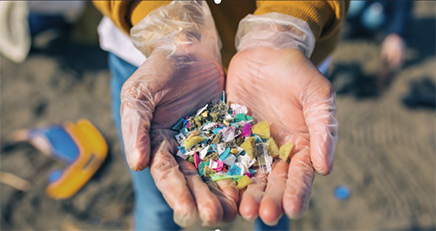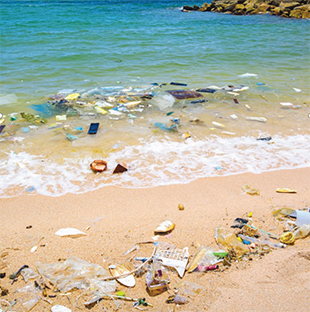Please note that you have eaten the plastic!
 Sep 13, 2023|
Sep 13, 2023| View:422
View:422Did you ever know that people's lives are now almost "eroded" by plastic inside and outside? From three meals a day, beverages, beer, clothes worn, and even the air breathed, it has been found that there are plastic "avatars". Since the invention of plastic in 1933, it has brought many conveniences to human life, from plastic bags to the packaging of various products. From disposable plastic shopping bags to packaging for various foods, beverages, clothing, and appliances, there is no exception to plastic.
Even our most commonly used items are made of plastic, such as electric fans, raincoats, stationery, phone cases, portable water cups, polyester fibers for making clothes, etc. In addition, most of the buried pipelines and building materials are also made of plastic. If you suddenly want to reduce plastic, you may find life difficult to move forward. The first to bear the brunt are takeout and milk tea, which can be considered one of the hardest hit areas for plastics. At the same time, there are many plastics that have quietly invaded people's bodies in places that people cannot see.
1、 There seems to be plastic in your favorite seafood
In 2019, the World Health Organization released an analysis report on microplastics in drinking water, calling for more in-depth research on microplastics in nature and their potential impact on human health. Usually, plastic fibers, particles, or films with dimensions less than 5 millimeters can be considered microplastics. Due to the severe situation of microplastics in the ocean, most seafood products have been detected to contain microplastics.

In addition to seafood, microplastics are also commonly detected in beer, salt, and honey. The maximum amount of microplastic particles per kilogram of sea salt is 681. The content of microplastics in German beer is as high as 150 per liter, and the content of microplastics in honey is as high as 400 per kilogram. There have been microplastics in more than 170 kinds of fish and marine organisms, including the aconite, oysters, clove fish, lobster and endangered bluefin tuna that people often eat.
Microplastics have a small particle size and large surface area, which may adsorb a large amount of heavy metals and organic pollutants. After being ingested by zooplankton, benthic animals, and fish, microplastics can be transported to higher levels of nutrition along the food chain, thereby affecting other types of marine organisms and ultimately endangering human health.
Microplastics have a clear negative impact on the health of the respiratory, digestive, and reproductive systems of the human body. However, as of now, research on how microplastics can harm human health is not yet sufficient. In addition to being transmitted layer by layer through the food chain, daily breathing, skin contact, etc. can also cause microplastics to enter the human body and even the blood.
Among them, traces of PET plastic were found in half of the blood samples, which are widely used in the manufacturing of beverage bottles. In addition, over one-third of blood samples contain polystyrene, a plastic commonly used in the manufacture of disposable food containers and many other products.
2、 Micro plastic, impenetrable
breathe
Actually, it's not just the ocean, from the ocean to land, from the equator to the poles, whether it's soil, water system, air, or food and drinking water such as fish and shellfish, microplastics have been detected. The atmospheric microplastics in some regions of China have been studied, mainly from the wear of synthetic textiles, synthetic rubber tires, and urban dust. Among them, the proportion of atmospheric microplastics is the highest, with textiles accounting for 34.8%. Research results show that every 3 grams of fabric washed releases 1300-1500 plastic particles.

Artificial fibers cannot be biodegradable, and 60% of the fabric used in daily clothing is made of artificial fibers. No wonder it has become the largest "killer" of air.
Skin contact
According to research, microplastic particles with a particle size below 100nm can penetrate the stratum corneum of the skin striatum. Plastic products such as surgical sutures in medical supplies can also increase the likelihood of human skin contact with microplastics. Micro plastic particles can penetrate the intestinal barrier and enter the bloodstream. Fortunately, most experiments have shown that microplastics have a low absorption efficiency in the human body (≤ 0.3%), are easy to ingest and excrete, with only a small portion (<1.5 μ m) Able to penetrate into tissues and organs.
Previously, many personal care products such as toothpaste and facial cleansers included plastic microspheres as exfoliators. Alternatively, due to the relatively uniform particle diameter, the spherical effect generated by the addition of plastic microspheres in products such as shower and facial cleansers can increase lubricity and give these products a silky and smooth feel when used.
In fact, in addition to toiletries, cigarettes, sparkling cosmetics, and other "artificial microplastics", more microplastics still come from "waste materials" such as fabric fibers. Except for fabric fibers, any plastic products scattered in nature such as forests and oceans that have not been properly recycled will change from "big plastic" to "micro plastic" under the influence of wind, water, sun, waves, and tides.







